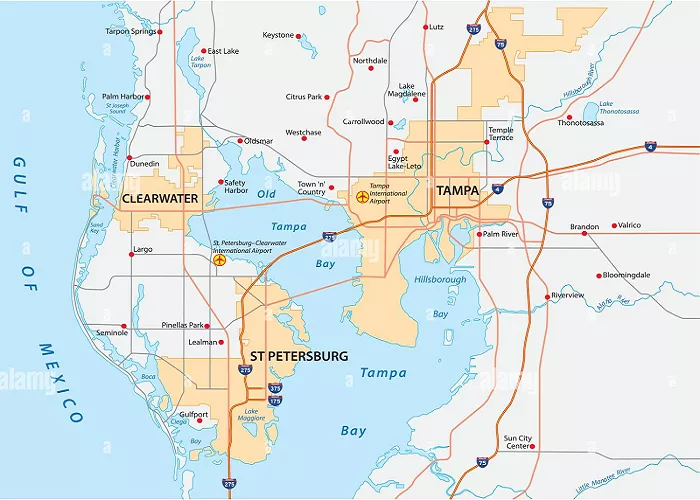Tampa Bay is a large natural harbor and estuary located along the west coast of Florida, United States. It serves as a crucial geographical feature for the surrounding cities and has played a significant role in the region’s development.
Tampa Bay is not just a body of water but a vital component of Florida’s Gulf Coast ecosystem and economy. It encompasses a diverse range of habitats, supports bustling urban centers, and offers recreational opportunities. Understanding its location and significance provides insight into the area’s history, culture, and environmental importance.
Geographical Location
Tampa Bay is situated along Florida’s Gulf Coast, indenting the state’s western shoreline. It spans approximately 400 square miles and is bordered by several key counties and cities:
- Hillsborough County: Located on the bay’s eastern shore, it encompasses the city of Tampa.
- Pinellas County: Situated on the bay’s western shore, it includes cities like St. Petersburg and Clearwater.
- Manatee and Sarasota Counties: Found to the south of the bay, contributing to its expansive watershed.
The bay is approximately 40 miles (65 km) long and varies in width, with its widest point reaching about 15 miles. It is partially sheltered from the Gulf of Mexico by the Pinellas Peninsula, creating a crescent-shaped inlet.
Major Waterways and Tributaries
Several rivers feed into Tampa Bay, enriching its ecosystem and influencing its salinity and water levels:
- Hillsborough River: Flows from the east, entering the bay near downtown Tampa.
- Alafia River: Merges into the bay’s southeastern section.
- Manatee River: Contributes to the bay’s northern expanse.
- Little Manatee River: Joins the bay near its southern boundary.
These rivers play a crucial role in transporting freshwater, nutrients, and sediments into the bay, supporting its diverse habitats.
Environmental Significance
Tampa Bay hosts a variety of ecosystems, including seagrass beds, mangroves, and salt marshes. These environments provide essential habitats for numerous species, such as:
- Dolphins: Commonly seen navigating the bay’s waters.
- Manatees: Frequent the bay, especially during cooler months.
- Sea Turtles: Utilize the bay’s beaches for nesting.
- Birds: Serves as a crucial stopover for migratory birds along the Gulf Coast.
The bay’s health is vital for both the local environment and economy, supporting commercial fishing, tourism, and recreational activities.
Human Settlements and Urban Development
The Tampa Bay area is home to several significant cities and communities:
- Tampa: Located on the bay’s eastern shore, it serves as the county seat of Hillsborough County and is known for its historic districts and cultural institutions.
- St. Petersburg: Situated on the western shore, it boasts a vibrant arts scene and is often referred to as “The Sunshine City” due to its record number of sunny days.
- Clearwater: Located to the northwest, it is famed for its pristine beaches along the Gulf of Mexico.
These urban centers, along with numerous smaller towns and communities, contribute to the bay’s dynamic cultural and economic landscape.
Historical Context
The area surrounding Tampa Bay has a rich history, dating back to indigenous populations such as the Tocobaga and Calusa tribes. European exploration began with Spanish conquistadors, including Pánfilo de Narváez in 1528 and Hernando de Soto in 1539, who both navigated the bay’s waters. Over the centuries, the bay has witnessed significant events, from colonial settlements to modern developments, shaping the region’s cultural and historical identity.
Economic Importance
Tampa Bay serves as a crucial economic hub for the region, supporting various industries:
- Port of Tampa Bay: One of the largest ports in the United States, facilitating international trade and commerce.
- Tourism: Attractions such as Busch Gardens, the Florida Aquarium, and numerous museums draw visitors worldwide.
- Fishing Industry: Both commercial and recreational fishing thrive in the bay’s abundant waters.
The bay’s accessibility and resources continue to drive economic growth and opportunities for surrounding communities.
Recreational Activities
The bay offers a plethora of recreational opportunities for residents and visitors alike:
- Boating and Sailing: The extensive waterways are ideal for various watercraft activities.
- Fishing: Anglers can pursue a diverse range of fish species in both inshore and offshore environments.
- Beaches: The Gulf Coast barrier islands, such as Clearwater Beach and Fort De Soto Park, provide sandy shores and clear waters for relaxation and swimming.
These activities contribute to the region’s high quality of life and attract tourists year-round.
Environmental Challenges and Conservation Efforts
Like many estuaries, Tampa Bay faces environmental challenges, including pollution, habitat loss, and the impacts of climate change. However, concerted conservation efforts have led to improvements in water quality, habitat restoration, and sustainable resource management. Organizations such as the Tampa Bay Estuary Program work collaboratively with government agencies, non-profits, and community stakeholders to protect and restore the bay’s natural resources.
Conclusion
Tampa Bay is a region full of life, culture, and natural beauty. Its central location on Florida’s Gulf Coast makes it a convenient destination for travelers, while its unique attractions and vibrant cities make it a memorable one. Whether you’re a beach lover, a sports fan, or just looking for a fun getaway, Tampa Bay has something for everyone.

